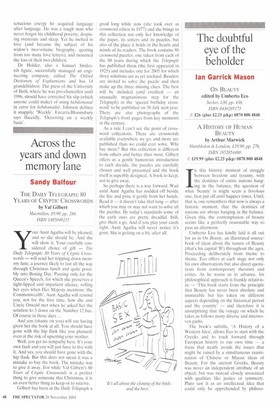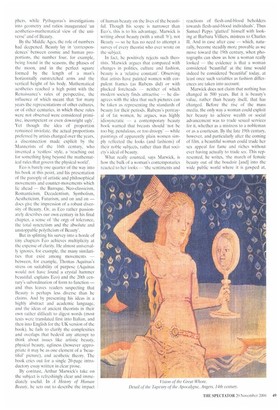The doubtful eye of the beholder
Ian Garrick Mason
ON BEAUTY edited by Umberto Eco Secker, £30, pp. 438, ISBN 0436205173 r) £26 (plus £2.25 p&p) 0870 800 4848 A HISTORY OF HUMAN BEAUTY by Arthur Marwick Hambledon & London, £19.99, pp. 276, ISBN 1852854480 t £19.99 (plus £2.25 p&p) 0870 800 4848 In this historic moment of struggle between freedom and tyranny, with the destinies of entire nations hanging in the balance, the question of what 'beauty' is might seem a frivolous one, best put off until happier times. Until, that is, one remembers that now is always a historic moment, that the destinies of nations are always hanging in the balance. Given this, the contemplation of beauty seems like a perfectly reasonable way to pass an afternoon.
Umberto Eco has kindly laid it all out for us in On Beauty, an illustrated sourcehook of ideas about the nature of Beauty (that's his capital 'EV) throughout the ages. Proceeding deliberately from theme to theme. Eco offers at each stage not only his own observations but also direct quotations from contemporary theorists and critics. As he warns us in advance, his philosophical approach is frankly relativistic — 'This book starts from the principle that Beauty has never been absolute and immutable but has taken on different aspects depending on the historical period and the country' — and therefore it is unsurprising that the voyage on which he takes us follows many diverse and interwoven paths.
The hook's subtitle, 'A History of a Western Idea', allows Eco to start with the Greeks and to track forward through European history to our own time — a focus that neatly avoids the issues that might be raised by a simultaneous examination of Chinese or Mayan ideas of Beauty. For the ancient Greeks, Beauty was never an independent attribute of an object, but was instead closely associated with qualities like justice or symmetry. Plato saw it as an intellectual idea that could only be apprehended by philoso
phers, while Pythagoras's investigations into geometry and ratios inaugurated an aesthetico-mathematical view of the universe' and of Beauty.
By the Middle Ages, the role of numbers had deepened. Beauty lay in 'correspondences' between cosmic and human proportions, the number four, for example, being found in the seasons, the phases of the moon, and in the perfect square formed by the length of a man's horizontally outstretched arms and the vertical height of his body. Mathematical aesthetics reached a high point with the Renaissance's rules of perspective, the influence of which meant that 'for many years the representations of other cultures, or of other centuries, in which these rules were not observed were considered primitive, incompetent or even downright ugly'. Yet though the idea of proportion remained inviolate, the actual proportions preferred by artists changed over the years, a disconnection made explicit by the Mannerists of the 16th century, who invented a 'restless' style, a 'reaching out for something lying beyond the mathematical rules that govern the physical world'.
Eco is barely one quarter of the way into his book at this point, and his presentation of the panoply of artistic and philosophical movements and counter-movements which lie ahead — the Baroque, Neo-classicism, Romanticism, Decadentism, Symbolism, Aestheticism, Futurism, and on and on — does give the impression of a robust diversity of Beauty. Or, as Eco rather passionately describes our own century in his final chapter, a sense of 'the orgy of tolerance, the total syncretism and the absolute and unstoppable polytheism of Beauty'.
But in splitting his survey into a horde of tiny chapters Eco achieves multiplicity at the expense of clarity. lie almost universally ignores, for example, the many similarities that exist among movements — between, for example, Thomas Aquinas's stress on suitability of purpose (Aquinas would not have found a crystal hammer beautiful, explains Eco) and the 20th century's subordination of form to function — and thus leaves readers suspecting that Beauty is perhaps less diverse than he claims, And by presenting his ideas in a highly abstract and academic language, and the ideas of ancient theorists in their own rather difficult to digest words (most texts were translated first into Italian, and then into English for the UK version of the book), he fails to clarify the complexities and overlaps that bedevil any attempt to think about issues like artistic beauty, physical beauty, ugliness (however appropriate it may be as one element of a 'beautiful' picture), and aesthetic theory. The book cries out for a single 20-page introductory essay written in clear prose.
By contrast, Arthur Marwick's take on the subject is refreshingly clear and immediately useful. In A History of Human Beauty, he sets out to describe the impact of human beauty on the lives of the beautiful. Though his scope is narrower than Eco's, this is to his advantage. Mat-wick is writing about beauty (with a small h'), not Beauty — so he has no need to attempt a survey of every theorist who ever wrote on the subject.
In fact, he positively rejects such theorists. Marwick argues that compared with changes in politics, culture and fashion, beauty is a 'relative constant'. Observing that artists have painted women with corpulent frames (as Rubens did) or with plucked foreheads — neither of which modern society finds attractive — he disagrees with the idea that such pictures can be taken as representing the standards of beauty for their periods. Rubens's portrayal of fat women, he argues, was highly idiosyncratic — a contemporary beauty book warned that breasts should 'not be too big, pendulous, or too droopy' — while paintings of apparently plain women simply reflected the looks (and fashions) of their noble subjects, rather than that society's ideal of beauty.
What really counted, says Marwick, is how the bulk of a woman's contemporaries reacted to her looks — 'the sentiments and
reactions of flesh-and-blood beholders towards llesh-and-blood individuals'. Thus Samuel Pepys 'glutted' himself with looking at Barbara Villiers, mistress to Charles II. And in case after case — which, naturally, become steadily more provable as we move toward the 19th century, when photographs can show us how a woman really looked — the evidence is that a woman considered 'beautiful' at the time would indeed be considered 'beautiful' today, at least once such variables as fashion differences are taken into account.
Marwick does not claim that nothing has changed in 500 years. But it is beauty's value, rather than beauty itself, that has changed. Before the rise of the mass media, the only way a woman could exploit her beauty to achieve wealth or social advancement was to trade sexual services for it, whether as a mistress to a nobleman or as a courtesan. By the late 19th century, however, and particularly after the coming of film, a beautiful woman could trade her sex appeal for fame and riches without ever having actually to trade sex.. This represented, he writes, 'the march of female beauty out of the boudoir [and] into the wide public world where it is gawped at,
and paid for, not by princes and bankers but by the masses'.
Marwick rightly notes that mass media also brought a wider range of human beauty to the world's attention: the near perfection of women as different from each other as Audrey Hepburn, Naomi Campbell or Twiggy. While beauty may come in many types, it's neither random nor subjective. Hard though it may always be for academic theorists like Eco to define, the rest of us will simply continue to know it when we see it.




























































































 Previous page
Previous page